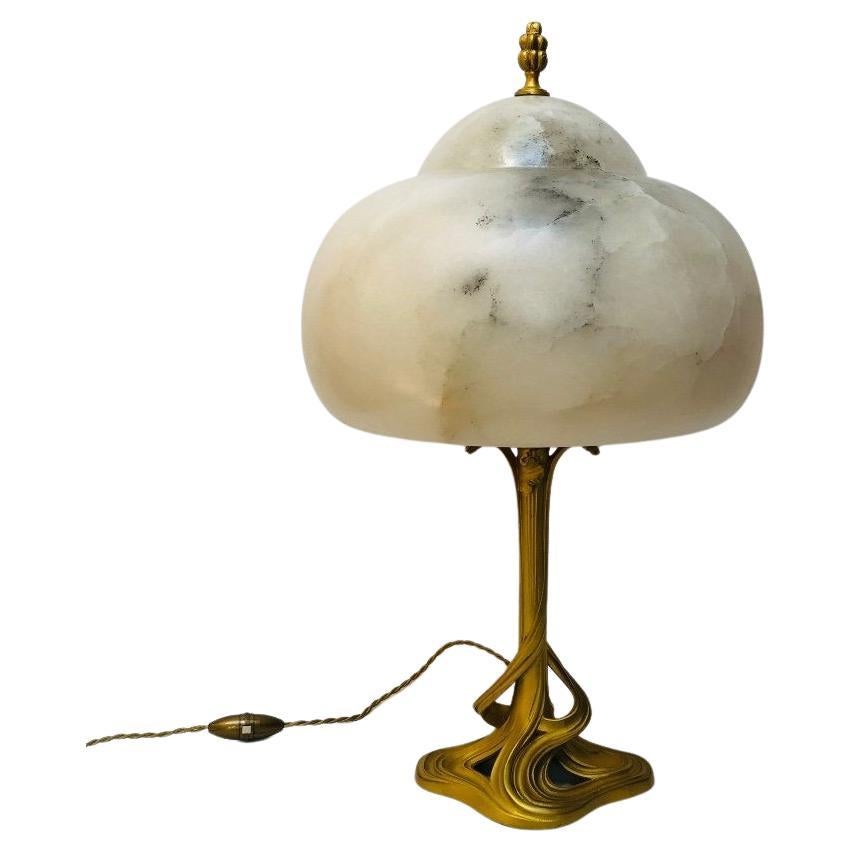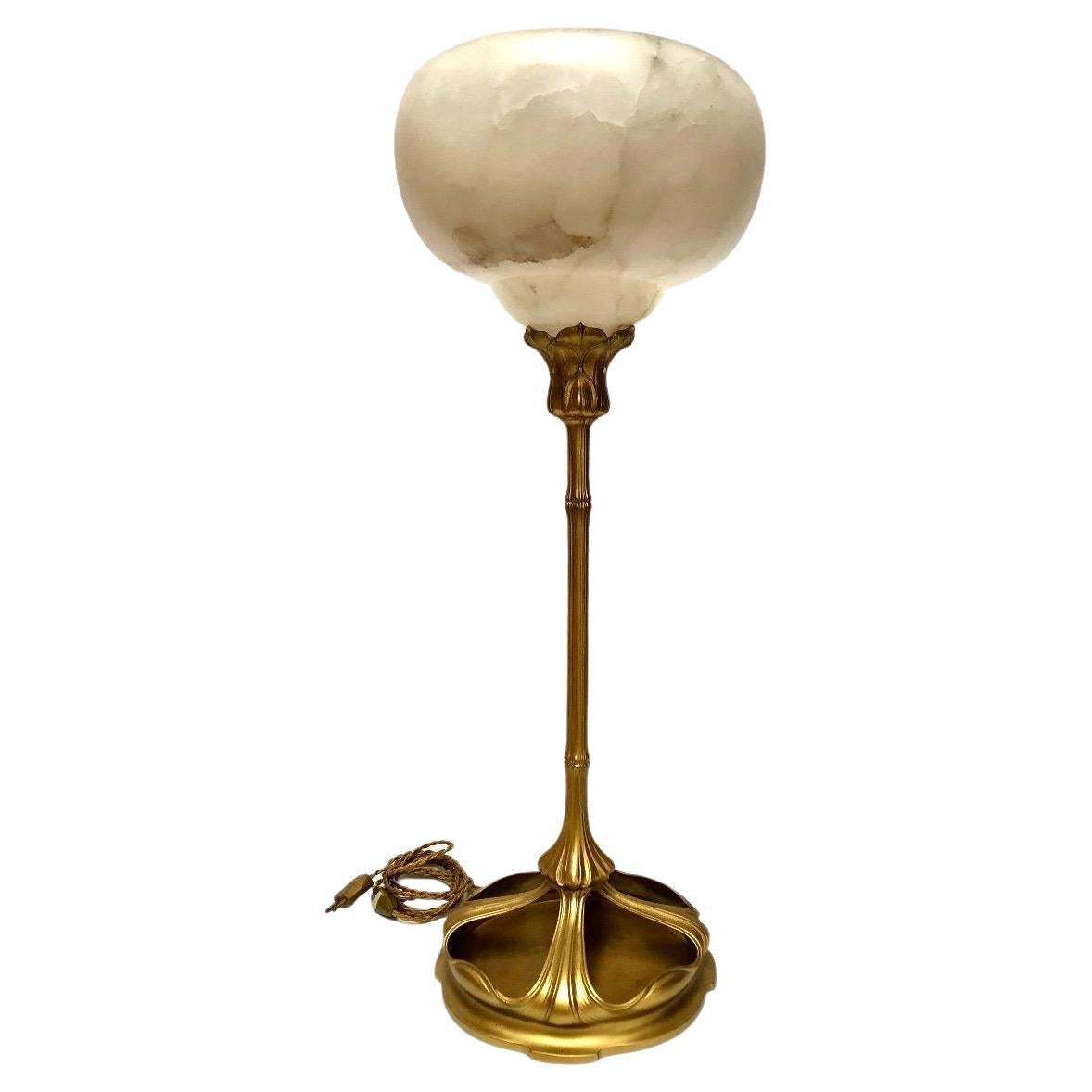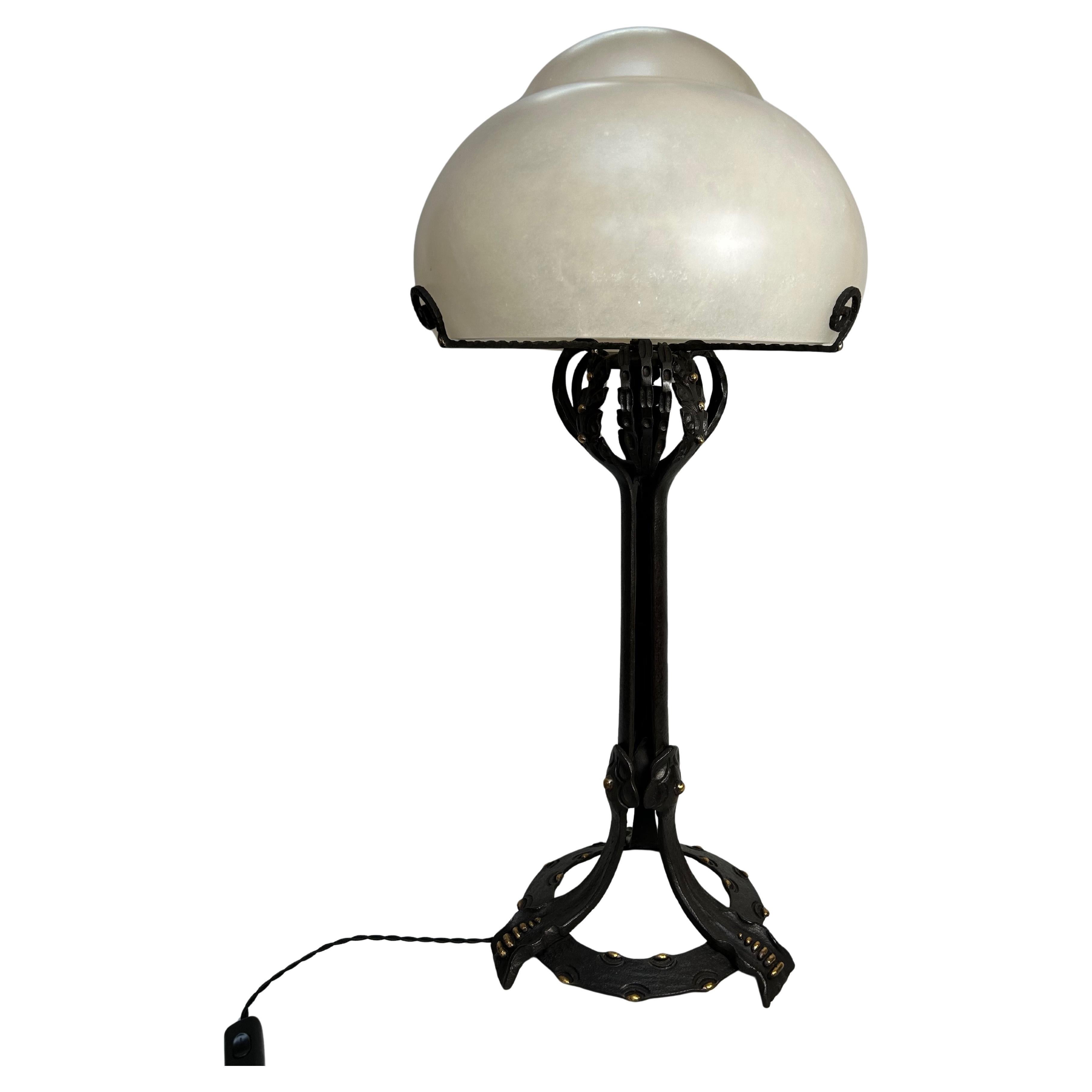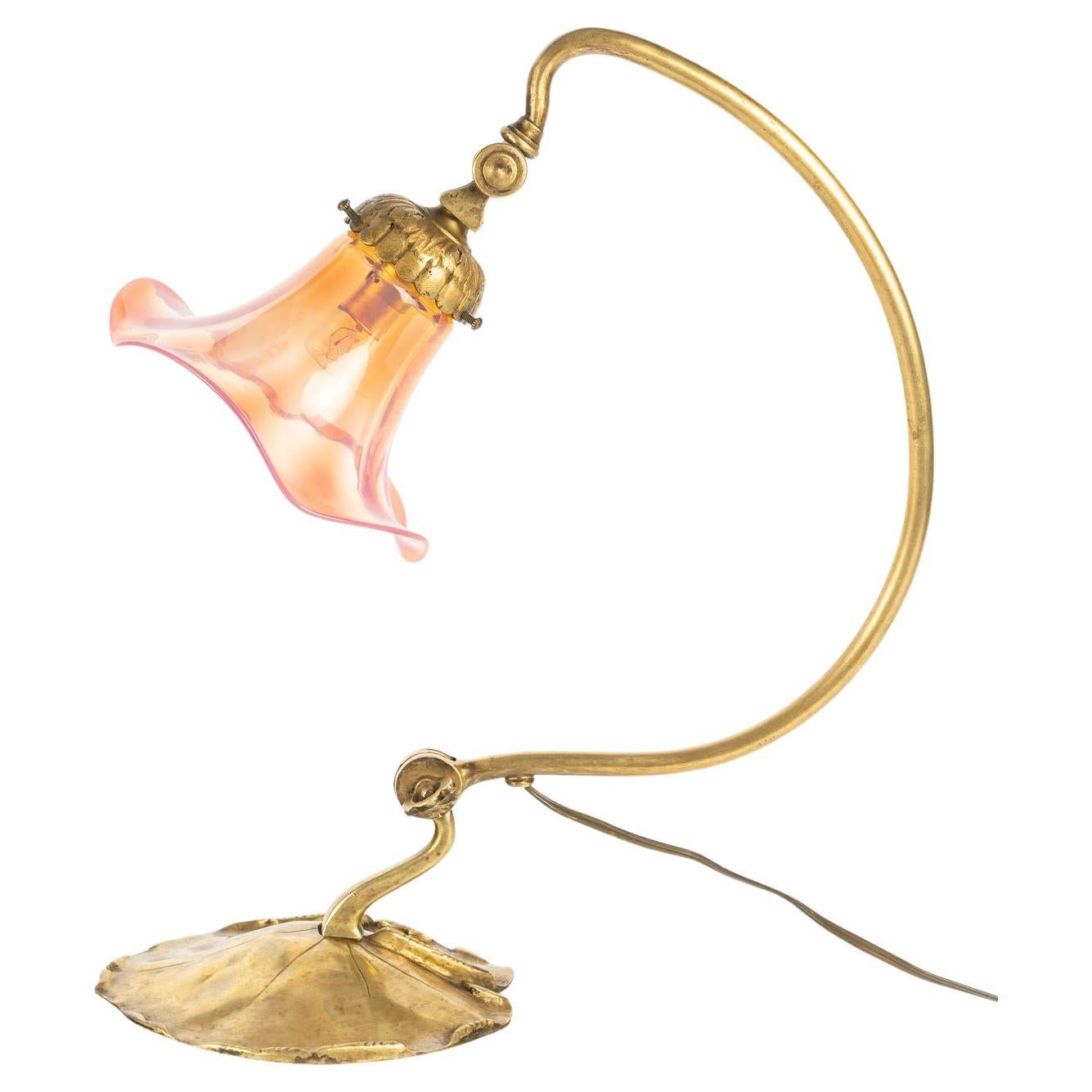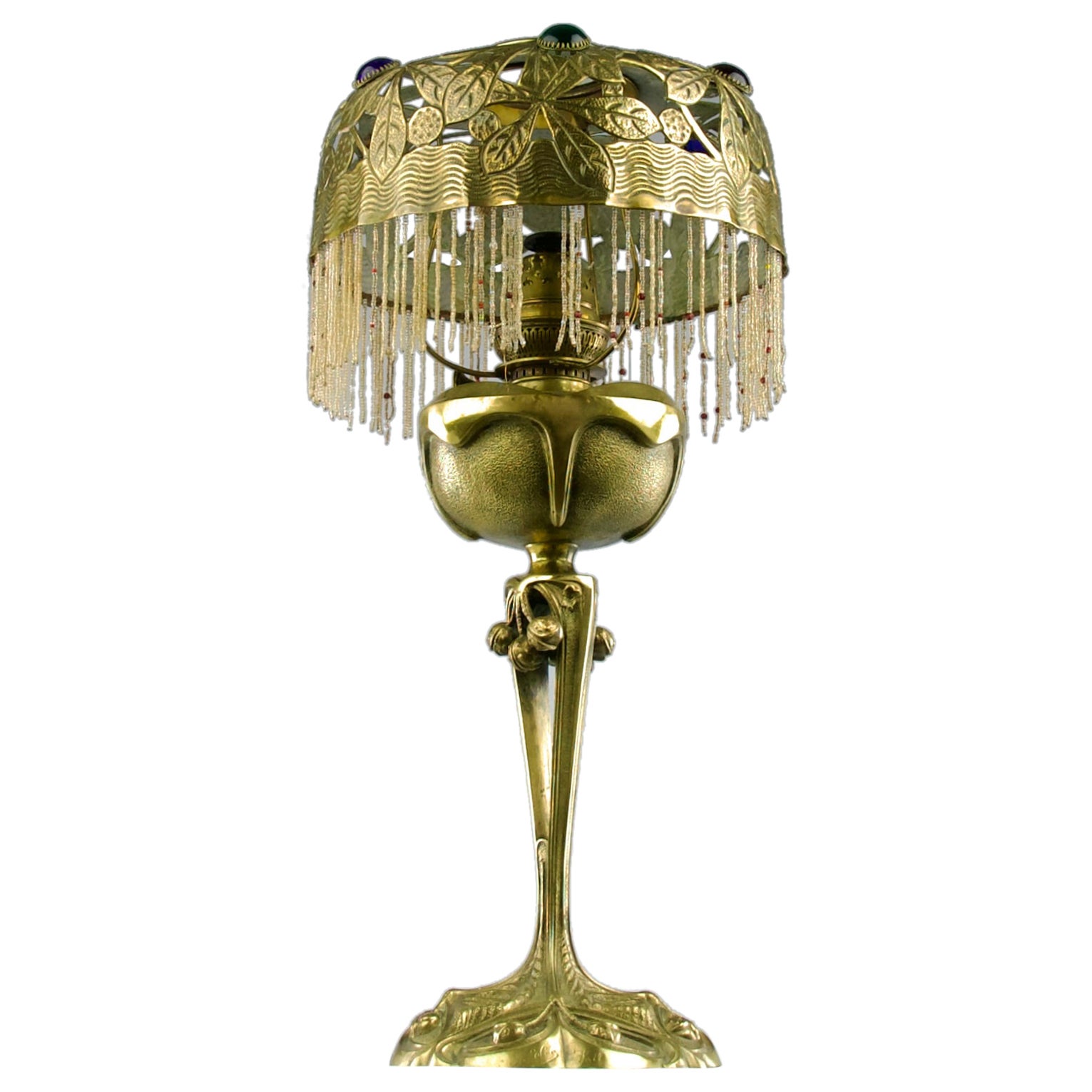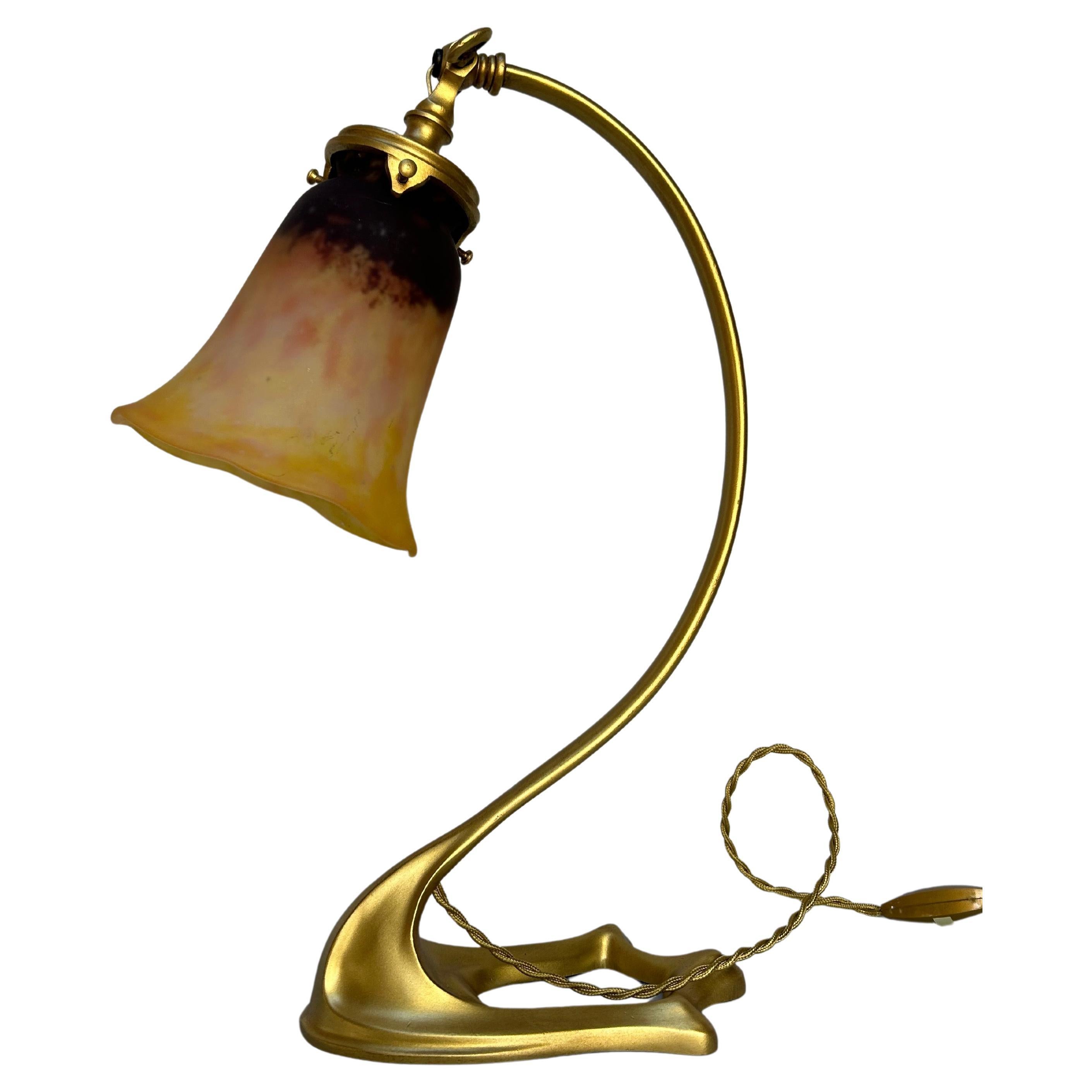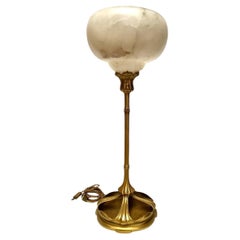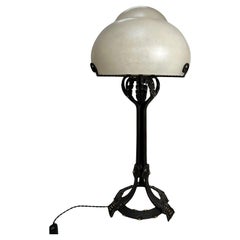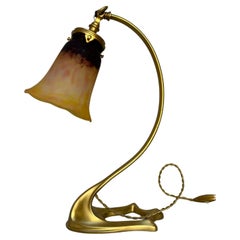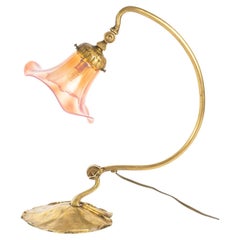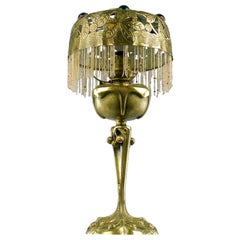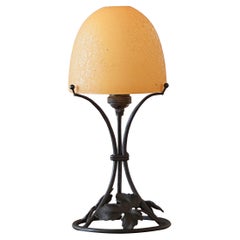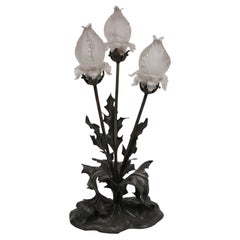Items Similar to Art Nouveau Lamp Attributed to Majorelle
Video Loading
Want more images or videos?
Request additional images or videos from the seller
1 of 14
Art Nouveau Lamp Attributed to Majorelle
$6,862.13
£5,213.27
€5,800
CA$9,642.36
A$10,589.21
CHF 5,450.92
MX$126,702.96
NOK 69,402.21
SEK 65,040.21
DKK 44,183.09
About the Item
Art nouveau lamp circa 1900.
Gilded bronze, alabaster shells.
Electrified and in perfect condition.
Height: 44 cm
Shell diameter: 22 cm
Weight: 4.5 kg
French cabinetmaker and designer
1859 - 1926
Louis Majorelle studied at the Ecole des Beaux-Arts in Paris from 1877, in 1879 he took over his father's furniture and ceramics factory. After the 1889 World's Fair, he abandoned the classical style and began looking for his own style.
Louis Majorelle, French cabinetmaker, born in Toul in 1859 - Died in Nancy in 1926.
He took over from his father Auguste (1825-1879), upon his death, interrupting his studies at the École des Beaux-Arts in Paris where he studied under Jean-François Millet.
He was converted to Art Nouveau by Émile Gallé.
He was the most important representative of the École de Nancy from 1894.
His work is characterized by the use of naturalist elements in his forms and marquetry.
He evolved towards simpler and more stripped-down forms shortly after his great success at the 1900 World's Fair and at the same time launched into mass production, which allowed him to quickly expand his catalog.
He worked mainly with Jacques Gruber.
He opened many exhibition stores, notably in Paris, Lyon and Oran, one of which he bought from Samuel Bing.
His creations are sold all over the world.
The more common furniture is the work of the workshops entrusted to Pierre Majorelle in Bouxières aux Dames in 1905
He continued in the same style after the war of 1914 despite the change in fashion towards Art Deco.
- Attributed to:Atelier Majorelle (Manufacturer)
- Dimensions:Height: 17.33 in (44 cm)Diameter: 8.67 in (22 cm)
- Power Source:Hardwired
- Voltage:110-150v,220-240v
- Style:Art Nouveau (Of the Period)
- Materials and Techniques:
- Place of Origin:
- Period:
- Date of Manufacture:1900
- Condition:
- Seller Location:NANTES, FR
- Reference Number:1stDibs: LU7403241846412
About the Seller
No Reviews Yet
Vetted Professional Seller
Every seller passes strict standards for authenticity and reliability
1stDibs seller since 2022
58 sales on 1stDibs
Typical response time: 2 hours
- ShippingRetrieving quote...Shipping from: NANTES, France
- Return Policy
More From This Seller
View AllMajorelle Art Nouveau Lamp
By Atelier Majorelle
Located in NANTES, FR
Majorelle Art Nouveau lamp
Large lamp around 1900 foot in gilded bronze and lampshade in alabaster.
Very good quality of bronze and pretty floral m...
Category
Early 20th Century French Art Nouveau Table Lamps
Materials
Alabaster, Bronze
Majorelle Exceptional and Rare Art Nouveau Bronze and Alabaster Lamp
By Louis Majorelle
Located in NANTES, FR
Majorelle lamp representing a flower, around 1900 in bronze and alabaster.
Not signed.
Electrified and in very good condition.
Measures: Diameter: 26 cm (base) 30 cm (shell)
He...
Category
Early 20th Century French Art Nouveau Table Lamps
Materials
Alabaster, Bronze
Majorelle Spectacular Art Nouveau Lamp
By Atelier Majorelle
Located in NANTES, FR
Ateliers Majorelle art nouveau lamp circa 1905.
Wrought iron base with bronze applications.
Alabaster shell.
Electrified lamp in perfect condition.
Tota...
Category
Early 20th Century French Art Nouveau Table Lamps
Materials
Alabaster, Bronze, Wrought Iron
Daum Nancy Art Nouveau Lamp Probably by Majorelle
By Louis Majorelle, Daum
Located in NANTES, FR
Art nouveau lamp circa 1900.
Gilt bronze base probably by Louis Majorelle.
Glass paste tulip signed Daum Nancy.
In perfect condition.
Electrified, B22 socket, bayonet bulb.
Height: ...
Category
Early 20th Century French Art Nouveau Table Lamps
Materials
Bronze
Art Nouveau lamp circa 1910
Located in NANTES, FR
Beautiful Art Nouveau lamp, circa 1910.
Brown-veined alabaster shell.
The base is bronze with floral decoration.
Electric and in perfect condition.
Total Height: 52 cm
Shell Diamete...
Category
Vintage 1910s French Art Nouveau Table Lamps
Materials
Alabaster, Bronze
Art Nouveau Lamp by Quezal
By Quezal
Located in NANTES, FR
Art Nouveau desk lamp, circa 1905.
Brass and copper frame.
Rare iridescent glass shade signed Quezal.
Electrified and in very good condition.
Height: 60.5 cm
Width: 21 cm
Depth: 35 cm
Weight: 2.6 kg
Quezal Art Glass
Quezal Art Glass – The Journal of Antiques and Collectibles – April 2003
By Malcolm Mac Neil
Some of the most beautiful and alluring art glass made in America during the early part of the 20th Century was made by the Quezal Art Glass and Decorating Company. Often in the shape of blossoming lilies with brilliant gold interiors and colorfully decorated with floral and other motifs inspired by nature, Quezal art glass ranks right alongside the iridescent glass of Louis Comfort Tiffany and Frederick Carder. Quezal artisans created an extensive range of decorative and useful items, including vases, compotes, finger bowls, open salts, candle holders, and shades for lighting fixtures, which are equivalent in terms of beauty and quality of craftsmanship to Tiffany’s Favrile and Carder’s Aurene glass. In recent years, glass collectors have discovered anew the special charms and appeal of Quezal art glass, and collector desirability for this lovely glassware has increased dramatically.
The Quezal Art Glass and Decorating Company was incorporated a century ago, on March 27, 1902. It was founded by Martin Bach, Sr., Thomas Johnson, Nicholas Bach, Lena Scholtz, and Adolph Demuth. The factory was located on the corner of Fresh Pond Road and Metropolitan Avenue in Maspeth, Queens, New York. In October 1902, the trademark “Quezal” was successfully registered. By 1904, roughly fifty glassworkers were employed at the works.
Martin Bach, Sr. was the president, proprietor, and guiding force behind this successful company. Born in 1862 in Alsace-Lorraine to German parents, he emigrated to the United States in 1891. Before his emigration, Bach worked in Saint-Louis, France, at the Saint-Louis Glass Factory. After Bach arrived in this country, he was hired by Louis C. Tiffany as the latter’s first batch-mixer or chemist at the newly established Tiffany Glass and Decorating Company, in Corona, Queens. After a period of about eight years, Bach left Tiffany and established his own glassworks. By this time, Bach had already started his small family. He and his German-born wife, Anne-Marie Geisser, whom he married in the fall of 1889, in Paris, France, had three children. Two daughters, Jennie and Louise, were born in France and a son, Martin, Jr., was born in Corona.
Bach was assisted by Thomas Johnson, an English immigrant, and Maurice Kelly, a native of Corona, both of whom were gaffers or master glassblowers. Johnson and Kelly helped pave the way for Quezal’s early accomplishments and later recognition. Thomas Johnson, like Bach, was a founding member and also previously employed by Louis C. Tiffany. Johnson’s association with Quezal, however, was relatively short lived. Around 1907, Johnson left for Somerville, Massachusetts, where he became involved in making Kew Blas...
Category
Antique Early 1900s American Art Nouveau Table Lamps
Materials
Brass, Copper
You May Also Like
Art Nouveau Bronze Lamp, circa 1900, Signed C.Berlier, Lyon.
Located in Saint-Ouen, FR
Art Nouveau bronze lamp, circa 1900, signed C.Berlier, Lyon.
Art Nouveau period lamp in bronze and pink transparent opaline glass by C.Berlier...
Category
20th Century French Art Nouveau Table Lamps
Materials
Bronze
Georges Leleu / L.R. Apollon, Antique Oil Lamp, French Art Nouveau 19th Century
By Georges Leleu
Located in PARIS, FR
Superb and rare Georges Leleu oil lamp with decorations of chestnuts and chestnut tree leaves in gilt bronze. Multicoloured cabochon in the removable hood. The dented setting of the ...
Category
Early 20th Century French Art Nouveau Table Lamps
Materials
Bronze
Table Lamp, Style: Jugendstil, Art Nouveau, Liberty, Year: 1900, French
Located in Ciudad Autónoma Buenos Aires, C
To take care of your property and the lives of our customers, the new wiring has been done.
We have specialized in the sale of Art Deco and Art Nouveau and Vintage styles since 1982....
Category
Antique Early 1900s French Art Nouveau Table Lamps
Materials
Iron
Table lamp by Louis Majorelle
By Louis Majorelle
Located in Ciudad Autónoma Buenos Aires, C
Art Nouveau table lamp, hammered bronze, green patina with frost glass lampshades, by Louis Majorelle (1859-1926). Signed Majorelle France.
Book L’ARGUS Des Ventes Aux Enchères VALE...
Category
Vintage 1920s French Art Nouveau Table Lamps
Materials
Bronze
Art Nouveau Table Lamp with brass and marble base and glass shade, 1920s
Located in Meulebeke, BE
France / 1920 / Table Lamp / brass, glass, marble / Art Nouveau
French Art Nouveau table lamp made around 1920. This rare lamp features a delicate decorated brass stem and black mar...
Category
Early 20th Century French Art Nouveau Table Lamps
Materials
Belgian Black Marble, Brass
Degue Art Nouveau Style Hand Painted Lamp
By Degué
Located in Guaynabo, PR
This is a hand painted half moon shaped glass paste shade lamp mounted in a wrought iron stem branches of roses and leaves. The half moon shade depicts an orange and royal blue color...
Category
Early 20th Century French Art Nouveau Table Lamps
Materials
Wrought Iron
$2,000 Sale Price
20% Off
More Ways To Browse
Stiffel Wood Lamp
Swirl Glass Shade
Swirl Mushroom Lamp
Table Lamp Girandole Style
Table Lamps Kutani
Tacchini Dining Table
Tensor Desk Lamp
Tensor Lamp Vintage
Tete De Femme Lamp
Three Candle Lamp
Tole Figure
Turquoise And Gold Lamp
Twig Lamp
Vintage Brass Goose
Vintage Brass Lava Lamp
Vintage Cannister
Vintage Clam Shell Lamp
Vintage Cylinder Lamp Shades
